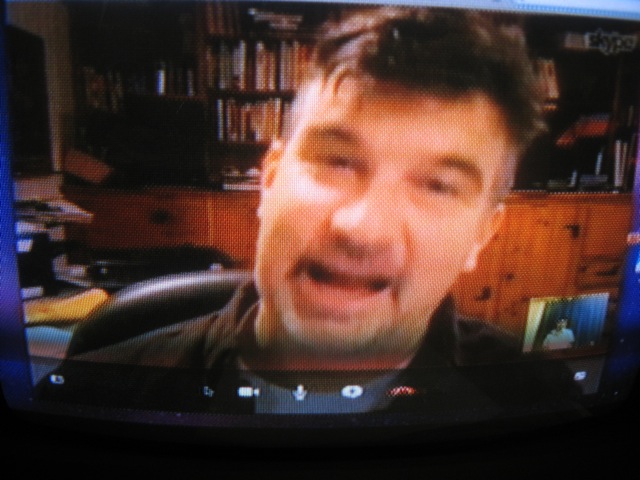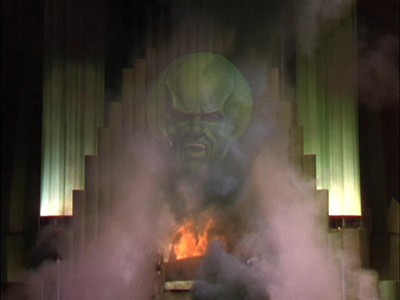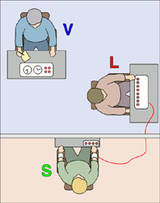Stanley Milgram was born on the 15 August 1933. In the early 1960s he carried out a series of experiments which had a not just a significant impact on the field of psychology, but had enormous influence in popular culture. These experiments touched on many profound philosophical questions concerning autonomy, authority, and the capacity of individuals to do the right thing in difficult circumstances.
The post Stanley Milgram: Life and legacy appeared first on OUPblog.
Let’s start with the horror:

Run for the hills, people.
On a Thursday morning in late November, I Skyped with students in Pine View Middle School, somewhere in Florida. The basic setup was that a small number of students gathered in the media room (I’m making that detail up, actually) to ask The Great Oz Head a variety of excellent questions. Once it was established that no, in fact I had no idea how to return them to Kansas, we talked for about 30 minutes about writing and my book, Bystander, which was read by all the language arts classes in the school, grades 6-8.

The program — that is, my enormous Oz Head — was televised live into 80% of the classrooms. The rest, I’m told, viewed the recorded presentation. In all, the Skype reached a population of 900 students. Crazy, I know.
At the risk of blowing my own horn, the reviews were good. Martha Ann Winterroth, who helped pull it all together, wrote to me with a curious follow-up question:
“Awesome!!!” “I LOVED it!!” Those are a couple of comments from the students as we disconnected from you!! It truly was an extremely successful Skype with you. However, there was one question that did not get asked that we would LOVE for you to (briefly) answer for us:
In chapter 27, did you intentionally have Mr. Scofield direct Eric to page 116 so that the reader would go back to that page and read about the quote from MLK (“In the end, we will remember not the words of our enemies but the silence of our friends.”)?
Thanks again. We appreciate your time and knowledge and words of wisdom. It is something that these kids will remember for a long, long time!
-
-
My interrogators. Not sure if the word “enthralled” leaps to mind.
Well, that was nice to read. I’m trying to relax with Skype, keep it loose and — I guess the word is – authentic. I just want to be a regular guy, talking clearly and honestly. (That’s my gimmick!) Anyway, in answer to the above question, I had no idea what they were talking about! Yes, on page 116 Mr. Scofield does introduce the quote from Martin Luther King, thus:
“What’s this got to do with us?” a boy asked.
“Everything,” the teacher answered. “It’s about having the courage to do the right thing.”
The bell rang. Eric grabbed his books and headed for the door. Mr. Scofield pointed to a photograph of Martin Luther King Jr. that had been tacked to the bulletin board. “King called it ‘the appaling silence.’”
-
Scofield was on his feet now, still teaching even after the bell, still declaiming quotes. “In the end we will remember not the words of our enemies, but the silence of our friends.”
-
Strange guy, that Scofield. A little hyper sometimes. But the image stuck in Eric’s head like a dart to a wall: a man attached to wires, pounding on walls, pleading, “Stop, somebody please, make them stop.” It was hard to pretend that the wires were not, in some strange inexplicable way, connected to him.
-
-
The famous Milgram Experiment, which is discussed
in the book during Mr. Scofield’s English class.
So then I turned to Chapter 27. Toward the end, Eric is distracted, thinking Griffin and Cody and Eric’s stolen bicycle. Mr. Scofield tells Eric to turn to page one hundred and sixteen, please. A number that was a total coincidence, believe me. I wish I was smart enough to think up that stuff! My compliments to whomever figured out that connection. It’s an impressive example of close reading and attention to detail.
I received another note, this one from Jamie, who first contacted me for a potential school visit.
Thanks so much for taking the time to Skype with us. The kids loved it! Not only were the students talking to you enthralled, but so was the entire school while they watched it! We now have a celebrity among us! Also, thank you for writing the book! As you know it was a school-wide initiative to have students become more aware of that bystander role. I, as an English teacher, loved how you showed them your “sloppy copy” of your books! You were fantastic!
Jamie
For more on the Milgram experiment . . .

. . . click here.







